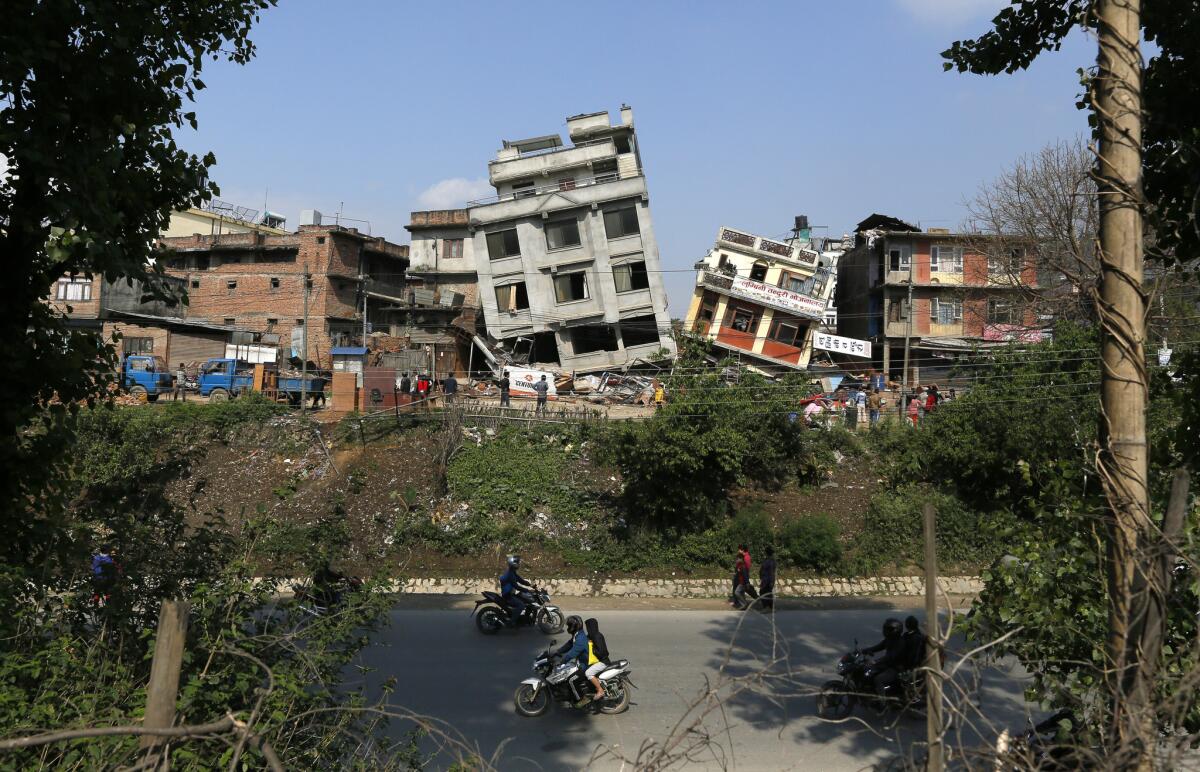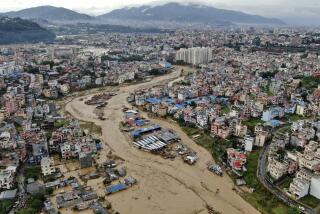Nepal’s government ill-equipped to handle earthquake disaster

- Share via
Reporting from Katmandu, Nepal — As the death toll from Nepal’s massive earthquake passed 4,200 on Monday, it was not just drinking water, hospital beds, gasoline, electricity and sanitary facilities that were in short supply.
Hope in the government’s ability to help was also increasingly scarce.
Unstable and resource-starved even in better times, Nepal’s government acknowledged Monday that it was ill-prepared to deal with a widening tragedy whose death toll could surpass 8,000, according to officials’ estimates. The tally of injured stood at more than 7,500.
Rescue and relief workers had yet to reach numerous remote mountain villages even as reports trickled out that vast numbers of homes had been reduced to heaps of rubble by Saturday’s temblor. Although nearly all of Nepal’s 100,000-member army was deployed for rescue and relief missions, residents in hamlets ringing Katmandu said they saw few security forces.
Soldiers and police in many cases were just as shocked and hungry as those they were trying to help, subsisting on the same diet of noodles and water.
The government’s struggling response has laid bare the costs of a protracted political crisis that has left this impoverished South Asian nation without a formal constitution or elected local leaders. There have been no elections at the local level since a state of emergency was declared in 1998, leaving far-flung districts, towns and villages — including some of the hardest hit areas — in the hands of appointed committees that are not equipped to manage emergency operations.
Seismologists had long warned that Nepal — which sits on a major fault and suffered a similar massive quake eight decades ago — was at risk of a devastating temblor. Conflict and political infighting have distracted from efforts to modernize infrastructure or build the economy, which depends heavily on foreign aid and remittances from Nepalese working overseas.
“One cannot predict when such disasters happen, but we’ve been told over the last 20 years that it would happen,” said Prashant Jha, a Nepal-born journalist with the Hindustan Times newspaper, who has written a book on the country. “When it did occur, was the Nepalese state in a position to cope with it? I don’t want to be too harsh at this moment, but the answer is clearly no.”
Six miles from Katmandu, the capital, in the medieval temple town of Bhaktapur, where 202 people were reported killed in Saturday’s magnitude 7.8 quake, residents said most homes in the city had collapsed, trapping some people underneath. In an account posted online, a pair of Nepalese reporters said that a soldier asked them to use their camera’s zoom lens to inspect debris about 50 yards away because the military lacked the equipment to do so.
“There was a strong presence of security forces on Saturday, but since yesterday there has been no state presence in Bhaktapur, leaving survivors to manage food and shelter on their own,” said Rabindra Puri, who works to restore old homes and temples.
In the coming weeks, Nepal’s largely ad hoc local government system will be further challenged to manage the flood of international aid and direct it to the neediest areas. Sara Shneiderman, an anthropology professor at the University of British Columbia who works in Nepal, said possible corruption and weak links between Katmandu and rural areas — where approximately 90% of Nepal’s 28 million people live — could make it difficult for officials to set priorities.
“Most people’s first impulse is to do the best they can, but with large funds there is always that risk” of misallocation, Shneiderman said.
Since a 10-year insurgency by Maoist rebels ended in 2006, Nepal’s squabbling political factions have missed multiple deadlines to draft a new constitution. The parties remain divided on basic issues such as how many states Nepal should have and how much power to invest in the country’s major ethnic minority groups — a messy stalemate that has frequently prompted disruptive protests in Katmandu.
For now, with aid slow to arrive and the scale of the tragedy still becoming clear, Nepalese are turning to the only people they can usually rely on: one another.
“The state has been largely absent in the last couple of decades, so people are used to providing for themselves,” Shneiderman said. “But this time they deserve better.”
Finance Minister Ram Sharan Mahat acknowledged that the relief effort had experienced delays.
“Our system wasn’t prepared to fix a problem of this magnitude, but the government is doing [its] best with the resources at our disposal,” Mahat told state-run Radio Nepal.
Nepal’s prime minister, Sushil Koirala, who was out of the country at the time of the quake for a summit and medical checkup, experienced delays returning to Katmandu. The government appeared paralyzed by the shock of the tragedy and seemed unsure how to respond as the death toll grew.
“There could have been somewhat stronger political leadership, with reassurances and communication with citizens, than we saw in the first day or two,” Jha said. “The society was almost coping with this on its own, more than relying on the government.”
By late Monday, the death toll in Nepal stood at 4,264, according to the country’s Ministry of Home Affairs.
Four Americans were reported to be among at least 17 people killed when an avalanche triggered by the earthquake roared through a base camp used by climbers preparing to scale Mt. Everest. The State Department on Monday confirmed the identities of two of them, Tom Taplin, a Santa Monica filmmaker, and Vinh Truong.
At least 69 people were reported killed in India and 25 in China’s Tibet region.
Nepalese Information Minister Minendra Rijal said Monday that 308 people had been rescued by helicopters and that authorities were trying to send more helicopters into remote areas.
Chief Secretary Leela Mani Paudyal said at a news conference that Nepal urgently needs tents, medical teams specializing in orthopedics, and collapsed-structure search-and-rescue teams.
Schools and banks remained closed, most businesses were shuttered and ATMs lacked electricity to dispense cash. Long lines of motorcycles and cars formed at gas stations that had fuel.
Sanjeev Bikram Rana, executive director of the Katmandu Water Supply Management Board, said the entire Katmandu Valley was reeling under drinking water shortages because of power cuts and severe damage to pipes.
Udav Prashad Timalsina, the top official for the Gorkha district near the epicenter, told the Associated Press that 223 people in his area were confirmed dead and that people were not getting adequate food or shelter from the government. He expected the toll to rise, as thousands were injured.
Nepal’s only international airport remained jammed with Nepalese and tourists trying to leave the country, including Americans. One traveler stranded there for two nights said airlines were providing them with little food or water, lavatories were backed up and conditions in the terminal resembled “a refugee camp.”
Thousands whose homes were destroyed or damaged — or were simply too afraid to return amid continuing aftershocks — camped out at Tundikhel, a wide expanse of green in the center of the capital. Others had erected canopies along sidewalks or set up tarpaulins in traffic circles to shade themselves from the intense heat and sporadic rainfall.
Soldiers were distributing drinking water to long lines of evacuees in Tundikhel as families sat in loose circles on blankets, chatting and selling snacks.
Jebin Gautam, a 24-year-old employee at a business consulting firm, was walking through Tundikhel on Monday morning looking for Westerners who might be able to help him reach his sister in Chicago to let her know their parents were safe.
Gautam worried that aftershocks could push the city further into a “danger zone,” given its aging infrastructure.
“If you look around you,” he said, pointing to a series of small, square buildings, “this city was not designed to withstand earthquakes. That’s why everyone is in Tundikhel now. They’re afraid the next quake will be the one that takes their house down.”
Abina Nepal, an American senior at Buckingham Browne and Nichols School in Cambridge, Mass., who was doing an internship as part of a spring project in Katmandu, has been trying to stay outside as aftershocks continue to rattle the region.
“The open spaces are getting dirtier and beginning to smell because of the amount of people sleeping, eating, going to the bathroom, and discarding trash there,” she said in an email Monday. “The scariest part is the uncertainty of the future; the tremors keep coming but no one knows when or how big the next one will be.”
Times staff writer Makinen reported from Katmandu and Bengali from Washington. Rai, in Katmandu, is a special correspondent. Special correspondent Michael Edison Hayden in Katmandu and Times staff writers Alexandra Zavis, Laura J. Nelson and Matt Pearce in Los Angeles contributed to this report.
Follow @JulieMakLAT on Twitter
More to Read
Sign up for Essential California
The most important California stories and recommendations in your inbox every morning.
You may occasionally receive promotional content from the Los Angeles Times.












